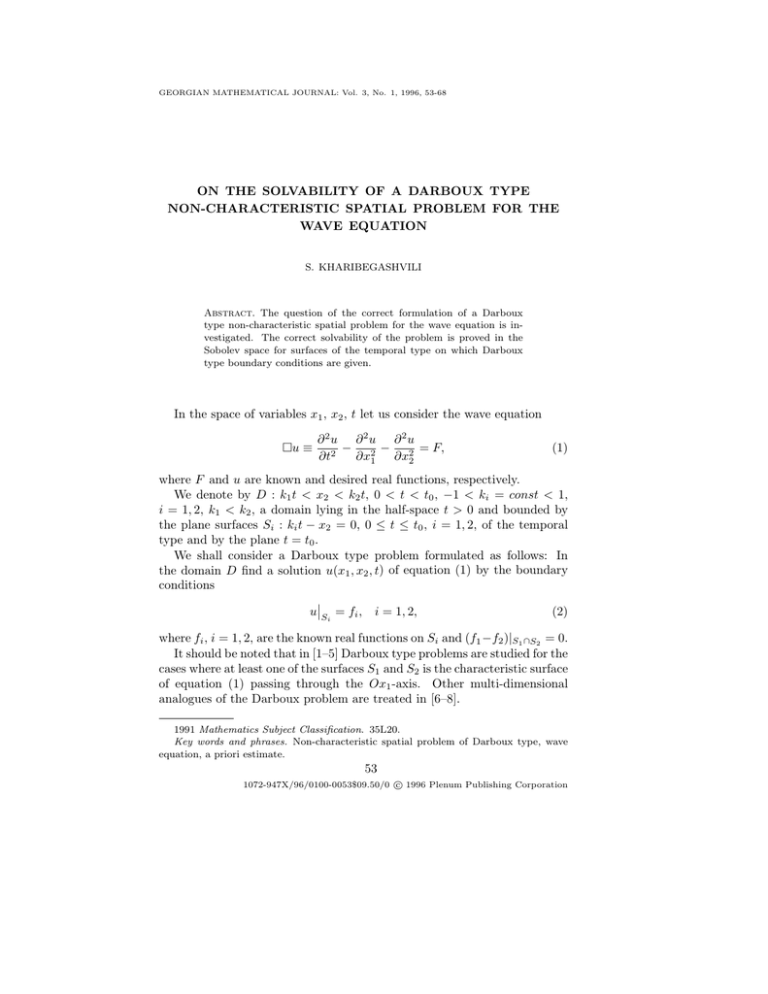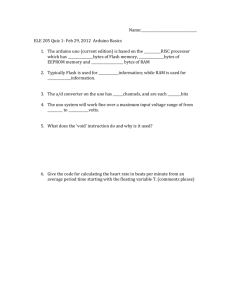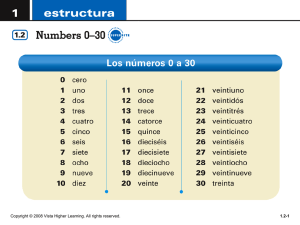ON THE SOLVABILITY OF A DARBOUX TYPE WAVE EQUATION
advertisement

GEORGIAN MATHEMATICAL JOURNAL: Vol. 3, No. 1, 1996, 53-68
ON THE SOLVABILITY OF A DARBOUX TYPE
NON-CHARACTERISTIC SPATIAL PROBLEM FOR THE
WAVE EQUATION
S. KHARIBEGASHVILI
Abstract. The question of the correct formulation of a Darboux
type non-characteristic spatial problem for the wave equation is investigated. The correct solvability of the problem is proved in the
Sobolev space for surfaces of the temporal type on which Darboux
type boundary conditions are given.
In the space of variables x1 , x2 , t let us consider the wave equation
u ≡
∂2u ∂2u ∂2u
−
= F,
−
∂t2
∂x21
∂x22
(1)
where F and u are known and desired real functions, respectively.
We denote by D : k1 t < x2 < k2 t, 0 < t < t0 , −1 < ki = const < 1,
i = 1, 2, k1 < k2 , a domain lying in the half-space t > 0 and bounded by
the plane surfaces Si : ki t − x2 = 0, 0 ≤ t ≤ t0 , i = 1, 2, of the temporal
type and by the plane t = t0 .
We shall consider a Darboux type problem formulated as follows: In
the domain D find a solution u(x1 , x2 , t) of equation (1) by the boundary
conditions
uS = fi , i = 1, 2,
(2)
i
where fi , i = 1, 2, are the known real functions on Si and (f1 −f2 )|S1 ∩S2 = 0.
It should be noted that in [1–5] Darboux type problems are studied for the
cases where at least one of the surfaces S1 and S2 is the characteristic surface
of equation (1) passing through the Ox1 -axis. Other multi-dimensional
analogues of the Darboux problem are treated in [6–8].
1991 Mathematics Subject Classification. 35L20.
Key words and phrases. Non-characteristic spatial problem of Darboux type, wave
equation, a priori estimate.
53
c 1996 Plenum Publishing Corporation
1072-947X/96/0100-0053$09.50/0
54
S. KHARIBEGASHVILI
As distinct from the cases considered in [1–5], the fact that none of
the surfaces S1 and S2 is characteristic results in the nonavailability of
an integral representation for regular solutions of problem (1), (2). The
latter circumstance somehow complicates the investigation of this problem.
Below we shall prove the existence and uniqueness theorems for regular as
well as for strong solutions of problem (1), (2) belonging to the class W21 .
Let C∗∞ (D) denote a space of functions belonging to the class C ∞ (D)
and having bounded supports, i.e.,
C∗∞ (D) = u ∈ C ∞ (D) : diam supp u < ∞ .
The spaces C∗∞ (Si ), i = 1, 2, are defined similarly.
The well-known Sobolev spaces will be denoted by W21 (D), W22 (D),
W21 (Si ), i = 1, 2. Note that the space C∗∞ (D) is an everywhere dense
subspace of the spaces W21 (D) and W22 , while C∗∞ (Si ) is an everywhere
dense subspace of the space W21 (Si ), i = 1, 2.
Definition. Let fi ∈ W21 (Si ), i = 1, 2, F ∈ L2 (D). A function u ∈
1
W2 (D) is called a strong solution of problem (1), (2) belonging to the class
W21 if there exists a sequence un ∈ C∗∞ (D) such that un → u in the space
W21 (D), un → F in the space L2 (D), and un |Si → fi in W21 (Si ), i = 1, 2,
i.e., for n → ∞
kun − ukW21 (D) → 0, kun − F kL2 (D) → 0,
kun |Si − fi kW21 (Si ) → 0,
i = 1, 2.
We have
Lemma 1. If −1 < k1 < 0, 0 < k2 < 1, then for any u ∈ W21 (D) there
holds the a priori estimate
kukW21 (D) ≤ C
2
X
i=1
kfi kW21 (Si ) + kF kL2 (D) ,
(3)
where fi = u|Si , i = 1, 2, F = u, and the positive constant C does not
depend on u.
Proof. Since the space C∗∞ (D) (C∗∞ (Si )) is an everywhere dense subspace
of the spaces W21 (D) and W22 (D) (W21 (Si )), by virtue of the well-known
theorems on embedding the space W22 (D) into the space W21 (D), and the
space W22 (D) into W21 (Si ) it is sufficient for us to prove that the a priori
estimate (3) holds for functions u of the class C∗∞ (D).
ON THE SOLVABILITY OF A DARBOUX TYPE PROBLEM
55
We introduce the notation
Dτ = (x, t) ∈ D : t < τ , D0τ = ∂Dτ ∩ t = τ , 0 < τ ≤ t0 ,
Siτ = ∂Dτ ∩ Si , i = 1, 2, Sτ = S1τ ∪ S2τ ,
ct).
α1 = cos([
n, x1 ), α2 = cos([
n, x2 ), α3 = cos(n,
Here n = (α1 , α2 , α3 ) denotes the external normal unit vector to ∂Dτ . One
can easily verify that
1
k
−k
−1
p 1
p
p 2
,
,
,
n
,
=
0,
nS1τ = 0, p
S
2τ
1 + k12
1 + k12
1 + k22
1 + k22
= (0, 0, 1).
n
D0τ
Therefore for −1 < k1 < 0, 0 < k2 < 1 we have
α3 Siτ < 0, i = 1, 2,
α3−1 (α32 − α12 − α22 )Si > 0, i = 1, 2.
(4)
On multiplying both parts of equation (1) by 2ut , where u ∈ C∗∞ (D),
F = u, and integrating the obtained expression with respect to Dτ , we
obtain due to (4)
Z
Z 2
∂ut
+ 2ux1 utx1 + 2ux2 utx2 dx dt −
∂t
Dτ
Dτ
Z
Z
(u2t + ux2 1 + u2x2 )dx +
−2 (ux1 ut α1 + ux2 ut α2 )ds =
2
F ut dx dt =
D0τ
S
+
=
Z
Zτ
Sτ
2
(ut + u2x1 + u2x2 )α3 − 2(ux1 ut α1 + ux2 ut α2 ) ds =
Z
(ut2 +u2x1 +u2x2 )dx+ α3−1 (α3 ux1 −α1 ut )2 +(α3 ux2 −α2 ut )2 +
D0τ
Sτ
+(α32
+
Z
Sτ
−
α12
−
α22 )ut2
ds ≥
Z
(u2t + u2x1 + ux2 2 )dx +
D0τ
α3−1 (α3 ux1 − α1 ut )2 + (α3 ux2 − α2 ut )2 ds.
(5)
56
S. KHARIBEGASHVILI
Assuming
w(τ ) =
Z
(u2t + u2x1 + u2x2 )dx,
D0τ
u
ei = α3 uxi − αi ut , i = 1, 2,
p
!
p
1 + k12
1 + k22
C1 = max
,
,
|k1 |
|k2 |
we find by (5) that
w(τ ) ≤ C1
Z
Sτ
≤ C1
Z
Sτ
≤ C1
Z
Sτ
u21 + u
e22 )ds +
(e
u21 + u
e22 )ds +
(e
e22 )ds +
(e
u21 + u
Z
Dτ
Zτ
0
Zτ
(F 2 + ut2 )dx dt ≤
dξ
Z
u2t dx +
D0ξ
Z
F 2 dx dt ≤
Dτ
w(ξ)dξ +
0
Z
F 2 dx dt.
(6)
Dτ
Let (x, τx ) be the point at which the surface S1 ∪ S2 intersects with the
straight line parallel to the t-axis and passing through the point (x, 0). We
have
Zτ
u(x, τ ) = u(x, τx ) + ut (x, t)dt,
τx
which implies
Z
D0τ
2
u (x, τ )dx ≤ 2
Z
2
u (x, τx )dx + 2|τ − τx |
D0τ
=2
Z
α3−1 u2 ds
+ 2|τ − τx |
Sτ
≤ C2
Z
u2 ds +
Z
Dτ
Sτ
Z
Z
D0τ
dx
ut2 (x, t)dt =
τx
u2t dx dt ≤
Dτ
u2t dx dt ,
where C2 = 2 max(C1 , t0 ).
On introducing the notation
Z
w0 (τ ) =
(u2 + u2t + u2x1 + u2x2 )dx
D0τ
Zτ
(7)
ON THE SOLVABILITY OF A DARBOUX TYPE PROBLEM
57
and combining inequalities (6) and (7), we obtain
w0 (τ ) ≤ C2
hZ
2
(u +
Sτ
e12
u
+
u
e22 )ds
+
Zτ
w0 (ξ)dξ +
0
Z
Dτ
i
F 2 dx dt ,
which by virtue of Gronwall’s lemma implies
Z
hZ
i
e22 )ds + F 2 dx dt ,
(u2 + u
e21 + u
w0 (τ ) ≤ C3
(8)
Dτ
Sτ
where C3 = const > 0.
∂
∂
−αi ∂t
is the internal differOne can easily verify that the operator α3 ∂x
i
ential operator on the surface Sτ . Therefore the following inequality holds
by virtue of (2):
Z
Sτ
(u2 + u
e21 + u
e22 )ds ≤ C4
2
X
i=1
kfi k2W 1 (Siτ ) ,
2
C4 = const > 0.
(9)
From (8) and (9) we obtain
w0 (τ ) ≤ C5
2
X
i=1
kfi k2W 1 (Siτ ) + kF k2L2 (Dτ ) , C5 = const > 0.
2
(10)
The integration of both parts of inequality (10) with respect to τ gives
us estimate (3).
In the sequel it will be assumed that −1 < k1 < 0, 0 < k2 < 1, i.e., that
inequalities (4) are fulfilled.
Lemma 2. The dependence domain for the point P0 (x01 , x02 , t0 ) ∈ D of
the solution u(x1 , x2 , t) of problem (1), (2) belonging to the class C 2 (D) or
W22 (D)
p is contained within the characteristic cone of the past ∂KP0 : t =
t0 − (x1 − x01 )2 + (x2 − x02 )2 with the vertex at the point P0 .
Proof. We set
ΩP0 = D ∩ KP0 , SiP0 = Si ∩ ∂ΩP0 , i = 1, 2,
p
where KP0 : t < t0 − (x1 − x01 )2 + (x2 − x02 )2 is the interiority of the
characteristic cone ∂KP0 .
To prove the lemma it is sufficient to show that if
fi S ≡ uS = 0, i = 1, 2, F Ω ≡ uΩ = 0,
(11)
iP
iP
P
0
then u|ΩP0 = 0.
0
0
P0
58
S. KHARIBEGASHVILI
Let us first consider the case with u ∈ C 2 (D). We denote by S3P0 the remainder part of the boundary of the domain ΩP0 , i.e., S3P0 = ∂ΩP0 \(S1P0 ∪
S2P0 ). Since by our construction the surface S3P0 is part of the characteristic
cone ∂KP0 of equation (1), we have
α3 S3P = const > 0, (α32 − α12 − α22 )S3P = 0,
(12)
0
0
where n = (α1 , α2 , α3 ) is the external normal unit vector to ∂ΩP0 .
On multiplying both parts of equation (1) by 2ut and integrating the
obtained expression with respect to the domain ΩP0 , we obtain due to (4),
(11), (12) and the arguments used in deriving (5) the following inequality:
Z
Z
2
(ut +u2x1 +u2x2 )α3 −2(ux1 ut α1 +ux2 ut α2 ) ds =
0 = 2 F ut dx dt =
ΩP 0
=
Z
∂ΩP0
∂ΩP0
α3−1 (α3 ux1 −α1 ut )2 +(α3 ux2 −α2 ut )2 +(α32 −α12 −α22 )u2t ds ≥
≥
Z
S3P0
α3−1 (α3 ux1 − α1 ut )2 + (α3 ux2 − α2 ut )2 ds.
(13)
∂
∂
−αi ∂t
is the internal
To obtain (13) we used the fact that the operator α3 ∂x
i
differential operator on the surface ∂ΩP0 and, in particular, on S1P0 ∪ S2P0 .
By virtue of (11) we have the equalities
∂u
∂u
− αi
= 0, i = 1, 2.
α3
∂xi
∂t S1P0 ∪S2P0
Since α3 > 0 on S3P0 , (13) implies
(α3 uxi − αi ut )
S3P0
= 0, i = 1, 2.
(14)
Taking into account that u ∈ C 2 (D) and the internal differential opera∂
∂
tors α3 ∂x
− αi ∂t
, i = 1, 2, are linearly independent on the two-dimensional
i
connected surface S3P0 , we immediately find by (14) that
(15)
uS3P ≡ const.
0
But by (11)
u
S3P0 ∩ S1P0 ∪S2P0
which on account of (15) gives us
uS
3P0
= 0,
≡ 0.
From (16) it follows in particular that u(P0 ) = 0.
(16)
ON THE SOLVABILITY OF A DARBOUX TYPE PROBLEM
59
If now we take an arbitrary point Q ∈ ΩP0 , then (11) implies that the
above equalities will hold if the point P0 is replaced by the point Q. Therefore, on repeating our previous reasoning for the domain ΩQ , we find that
u(Q) = 0. Thus for the case with u ∈ C 2 (D) we obtain u|ΩP0 = 0.
Let now u ∈ W22 (D) and equalities (11) be fulfilled. One can easily verify
that inequality (13), where the point P0 is replaced by the point Q, also
holds for any point Q ∈ ΩP0 , i.e.,
Z
S3Q
α3−1 (α3 ux1 − α1 ut )2 + (α3 ux2 − α2 ut )2 ds ≤ 0.
Hence by virtue of the fact that α3 |S3Q = const > 0 we obtain
Z
S3Q
(α3 ux1 − α1 ut )2 + (α3 ux2 − α2 ut )2 ds = 0.
(17)
Let ΓQ denote a piecewise-smooth curve which is the boundary of the twodimensional connected surface S3Q . It is obvious that
ΓQ = S3Q ∩ S1Q ∪ S2Q .
(18)
Recalling the fact that on the surface S3Q the internal differential operators
∂
∂
, i = 1, 2, are independent for any v ∈ W21 (S3Q ) it is not
− αi ∂t
α3 ∂x
i
difficult to obtain the estimate
+
Z
S3Q
Z
v 2 ds ≤ C
S3Q
Z
v 2 ds +
ΓQ
(α3 vx1 − α1 vt )2 + (α3 vx2 − α2 vt )2 ds ,
(19)
where C = const > 0 does not depend on v and the trace v|ΓQ ∈ L2 (ΓQ ) is
correctly defined by virtue of the respective embedding theorem.
Since u ∈ W22 (D), the traces u|S3Q ∈ W21 (S3Q ), u|ΓQ ∈ L2 (ΓQ ) are
correctly defined by virtue of the embedding theorems. Therefore by (11)
and (18) we have
uΓ = 0.
Q
(20)
60
S. KHARIBEGASHVILI
From (17), (19) and (20) we obtain
Z
Z
2
u ds ≤ C
u2 ds +
+
Z
S3Q
S3Q
ΓQ
(α3 ux1 − α1 ut )2 + (α3 ux2 − α2 ut )2 ds = 0
which immediately implies
Z
u2 ds = 0,
S3Q
u S
3Q
= 0,
∀Q ∈ ΩP0 .
(21)
Since u ∈ W22 (D), we conclude due to (21) and Fubini’s theorem that
uΩ = 0.
P0
Remark 1. Lemma 2 implies that the wave process described by problem
(1), (2) propagates at finite velocity. Therefore if u ∈ C ∞ (D) is a solution
of problem (1), (2) for fi ∈ C∗∞ (Si ), i = 1, 2, F ∈ C∗∞ (D), then we have
u ∈ C∗∞ (D).
For our further discussion we shall need
Lemma 3. Let G be a bounded subdomain a of D having a piecewisesmooth boundary and bounded from above by the plane t = t0 and from the
sides by the planes S1 , S2 and the piecewise-smooth surfaces S3 , S4 of the
temporal type on which the following inequalities are fulfilled:
α3 S < 0, α3 S < 0,
(22)
3
4
where n = (α1 , α2 ,p
α3 ) is the unit normal vector to ∂G and S3 ∩ S4 = ∅.
Let KP+0 : t > t0 + (x1 − x01 )2 + (x2 − x02 )2 be the domain bounded by the
characteristic cone of the future with the vertex at the point P0 (x10 , x02 , t0 ).
Let u0 ∈ C ∞ (G) and gi = u0 |∂G∩Si , i = 1, 2, F0 = u0 , X = supp g1 ∪
supp g2 ∪ supp F0 , Y = ∪ KP+0 .
P0 ∈X
We denote by S3ε , S4ε ε-neighborhoods of the surfaces S3 , S4 , where ε is
a fixed sufficiently small positive number. Then if
(23)
u0 S ∪S4 = 0,
33
3
(24)
Y ∩ S3 ∪ S4 = ∅,
then the function
(
u0 (P ),
u(P ) =
0,
P ∈ G,
P ∈ D\G
ON THE SOLVABILITY OF A DARBOUX TYPE PROBLEM
is a solution of problem (1), (2)
(
gi (P ),
fi (P ) =
0,
(
F0 (P ),
F (P ) =
0,
61
of the class C∗∞ (D) for
P ∈ ∂G ∩ Si ,
i = 1, 2,
P ∈ Si \(∂G ∩ Si ),
P ∈ G,
P ∈ D\G.
Proof. To prove this lemma it is sufficient to show that the function u0 ∈
C ∞ (G) vanishes on the set G ∩ (S3ε ∪ S4ε ).
Let P0 ∈ G ∩ (S3ε ∪ S4ε ) be an arbitrary point of this set. We shall show
that u0 (P0 ) = 0.
Let us use the notation of Lemma 2:
SiP0 = Si ∩ ∂ΩP0 , i = 1, 2, 3, 4,
ΩP0 = G ∩ KP0 ,
S5P0 = ∂KP0 ∩ ∂ΩP0 .
5
It is obvious that ∂ΩP0 = ∪ SiP0 .
i=1
By the assumptions of Lemma 3 we have
α3 SiP < 0, i = 1, 2, 3, 4; α3−1 (α32 − α12 − α22 )S > 0, i = 1, 2, 3, 4;
iP
0
0
α 3 S
> 0, (α32 − α12 − α22 )S
= 0,
5P
5P0
(25)
(26)
0
where n = (α1 , α2 , α3 ) is the unit normal vector to ∂ΩP0 .
Due to (23), (24) and P0 ∈ G ∩ (S3ε ∪ S4ε ) we have
u0 S = 0, i = 1, 2, 2, 4; u0 Ω = F0 Ω = 0.
iP0
P0
P0
(27)
On multiplying both sides of the equation u0 = F0 by 2u0t and on
integrating the obtained expression by ΩP0 , we find by virtue of (25)–(27)
and the arguments used in deriving inequalities (5) and (13) that
Z
Z
h ∂u
∂u0 2
∂u0
0
+
dx dt =
α31 α3
− α1
0=2
F0
∂t
∂x1
∂t
Ω P0
∂ΩP0
∂u0 2 i
∂u0
∂u0 2 2
ds ≥
+ α3
+ α3 − α12 − α22
− α2
∂x2
∂t
∂t
Z
h ∂u
∂u0 2 ∂u0
∂u0 2 i
0
≥
α3−1 α3
+ α3
ds.
− α1
− α2
∂x1
∂t
∂x2
∂t
S5P0
Since α3 |S5P0 > 0, the latter formula gives us
α3
∂u0
∂u0
− αi
= 0, i = 1, 2.
∂xi
∂t S5P0
62
S. KHARIBEGASHVILI
The rest of the reasoning repeats the proof of Lemma 2.
u(P0 ) = 0.
Therefore
Remark 2. One can easily verify that Lemma 3 remains valid if conditions
(22) are not fulfilled on some set ω ⊂ S3 ∪ S4 of the zero two-dimensional
m
measure, i.e., α3 |ω = 0. In particular, if ω = ∪ γi is the union of the finite
i=1
number of smooth curves γi ⊂ S3 ∪ S4 and α3 |ω = 0, α3 |(S3 ∪S4 )\ω < 0, then
Lemma 3 remains valid. We shall use this fact in the sequel when proving
Theorem 1.
Remark 3. Also note that Lemmas 2 and 3 actually provide us with the
technique for constructing the solution of problem (1), (2) to be described
below when proving Theorem 1. This technique consists in reducing the
initial problem (1), (2) to the mixed problem for a second-order hyperbolic
equation in the finite cylinder.
It will be assumed below that in the boundary conditions (2) the functions
f1 and f2 vanish on the straight line Γ = S1 ∩ S2 , i.e.,
fi Γ = 0, i = 1, 2.
(28)
Functions of the class W21 (Si ) which satisfy equality (28) will be denoted
◦
by W 12 (Si , Γ), i.e.,
We have
◦
W 12 (Si , Γ) = f ∈ W21 (Si ) : f Γ = 0 , i = 1, 2.
◦
Theorem 1. For any fi ∈ W 12 (Si , Γ), i = 1, 2, F ∈ L2 (D) there exists
a unique strong solution u of problem (1), (2) of the class W21 for which
estimate (3) holds.
Proof. We denote by Si0 : ki t − x2 = 0, 0 ≤ t < +∞, i = 1, 2, the halfplane containing the support Si from the boundary conditions (2), and by
D0 the dihedral angle between the half-planes S10 and S20 . It is known that
◦
the function fi ∈ W 12 (Si , Γ) can be extended into the half-plane Si0 as a
◦
◦
function fei of the class W 12 (Si0 ), i.e., (fi − fei )|Si = 0, fei ∈ W 12 (Si0 ), i = 1, 2.
We assume that
(
F (P ), P ∈ D,
Fe (P ) =
0,
P ∈ D0 \D.
Obviously, Fe ∈ L2 (D0 ).
If C0∞ (D0 ), C0∞ (Si0 ), i = 1, 2, are the spaces of finite infinitely differentiable functions, then, as we know, these spaces are everywhere dense
ON THE SOLVABILITY OF A DARBOUX TYPE PROBLEM
63
in the spaces L2 (D0 ), W21 (Si0 ), i = 1, 2, respectively. Therefore there are
sequences Fn ∈ C0∞ (D0 ) and fin ∈ C0∞ (Si0 ), i = 1, 2, such that
lim kFe − Fn kL2 (D0 ) = lim kfei − fin kW21 (Si0 ) = 0,
n→∞
n→∞
i = 1, 2.
(29)
In the plane of the variables x2 , t we introduce the polar coordinates r, ϕ.
The t-axis is assumed to be the polar axis, while the polar angle ϕ is counted
from the t-axis and assumed to be positive in the clockwise direction. We
denote by ϕi the value of the dihedral angle between the half-planes Si0 and
x2 = 0, 0 ≤ t < +∞, i = 1, 2. Since the half-planes Si0 are of the temporal
type (−1 < k1 < 0, 0 < k2 < 1), we have 0 < ϕi < π4 , i = 1, 2.
In passing from the Cartesian cordinates x1 , x2 , t to the system of coordinates x1 , τ = log r, ϕ, the dihedral angle D0 transforms to an infinite
layer
(30)
H = − ∞ < x1 < ∞, −∞ < τ < ∞, −ϕ1 < ϕ < ϕ2
while in terms of the previous notations for the functions u and F equation
(1) takes the form
e−2τ L(τ, ϕ, ∂)u = F,
(31)
∂
∂
where ∂ = ( ∂x
, ∂ , ∂ϕ
), and L(τ, ϕ, ∂) is a second-order hyperbolic type
1 ∂τ
differential operator with respect to τ with infinitely differentiable coefficients which depend on τ and ϕ.
In the half-plane x1 , ϕ let us consider a convex domain Ω of the class C ∞
bounded by the straight line segments `1 : ϕ = −ϕ1 , `2 : ϕ = ϕ2 and the
curves γ1 : x1 = g(ϕ), −ϕ1 ≤ ϕ ≤ ϕ2 , γ2 : x2 = −g(ϕ), −ϕ1 ≤ ϕ ≤ ϕ2 .
Here g(ϕ) ∈ C ∞ (−ϕ1 , ϕ2 ) ∩ C[−ϕ1 , ϕ2 ], g(ϕ) > 0 for −ϕ1 ≤ ϕ ≤ ϕ2 ,
g 0 (ϕ) > 0 for −ϕ1 < ϕ < 0, g 0 (0) = 0, g 0 (ϕ) < 0 for 0 < ϕ < ϕ2 , g 00 (ϕ) < 0
for −ϕ1 < ϕ < ϕ2 , and
(32)
min g(−ϕ1 ), g(ϕ2 ) > 1 + t0 + d,
where
d = max(d1 , d2 , d3 ), di =
sup
(x1 ,x2 ,t)∈supp fi
d3 =
sup
(x1 ,x2 ,t)∈supp F
|x1 |, i = 1, 2,
|x1 |.
We denote by H0 ⊂ H a cylindrical domain Ω×(−∞, ∞) of the class C ∞
where (−∞, ∞) is the τ -axis, and by ∂H0 its lateral surface ∂Ω × (−∞, ∞).
When the inverse transformation (x1 , τ, ϕ) → (x1 , x2 , t) takes place, the
cylindrical domain H0 will transform into the infinite domain G0 ⊂ D0
bounded by the surfaces Sei = Si0 ∩ ∂G0 , i = 1, 2, and also by the surfaces
Se3 and Se4 .
64
S. KHARIBEGASHVILI
We shall show below that the surfaces Se3 and Se4 are of the temporal type
and the following conditions are fulfilled on them:
(33)
α3 (Se ∪Se )\ω < 0, α3 ω = 0,
3
4
where ω is the union of two smooth curves ω1 and ω2 lying on Se3 ∪ Se4 .
Indeed, one can easily verify that the surfaces Se1 and Se2 are the images of
the cylindrical surfaces S10 = `1 ×(−∞, ∞) ⊂ ∂H0 and S20 = `2 ×(−∞, ∞) ⊂
∂H0 , while the surfaces Se3 and Se4 are the images of the surfaces S30 =
γ1 × (−∞, ∞) ⊂ ∂H0 and S40 = γ2 × (−∞, ∞) ⊂ ∂H0 when the inverse
transformation (x1 , τ, ϕ) → (x1 , x2 , t) takes place. We divide the surface S30
0
0
into two parts S30 = S3+
∪ S3−
, where
0
0
S3+
= γ1+ × (−∞, ∞), S3−
= γ1− × (−∞, ∞),
γ1+ : x1 = g(ϕ), 0 < ϕ < ϕ2 , γ1− : x1 = g(ϕ), −ϕ1 < ϕ < 0.
It is easy to see that when the inverse transformation (x1 , τ, ϕ) → (x1 , x2 , t)
0
occurs, the image Se3+ ⊂ Se3 of the surface S3+
admits the parametric representation
Se3+ : x1 = g(ϕ), x2 = σ sin ϕ, t = σ cos ϕ; 0 < ϕ < ϕ2 , 0 < σ < +∞.
Hence for the unit normal vector n = (α1 , α2 , α3 ) to ∂G0 on the segment
Se3+ we obtain the expression
!
0
0
σ
−g
g
(ϕ)
ϕ
(ϕ)
cos
sin
ϕ
nSe = p
, p
, p
(34)
.
3+
σ 2 + g 0 2 (ϕ)
σ 2 + g 0 2 (ϕ)
σ 2 + g 0 2 (ϕ)
Taking into account the structure of the domain Ω, by (34) we find that Se3+
is a surface of the temporal type on which α3 |Se < 0. Similar statements
3+
are proved also for the other segments Se3− , Se4+ and Se4− of the surfaces Se3
and Se4 . To prove finally that condition (33) is fulfilled, it remains for us
only to note that component α3 of the unit normal vector n vanishes on the
curves
ω1 = ∂ Se3+ ∩ ∂ Se3− , ω2 = ∂ Se4+ ∩ ∂ Se4−
e1 : x1 = g(0), ϕ = 0, −∞ < τ <
which are the images of the straight lines ω
∞, and ω
e2 : x1 = −g(0), ϕ = π, −∞ < τ < ∞, and the third component
α3 of the unit normal vector n is equal to zero.
On the boundary ∂G0 of the domain G0 we define a function νn (x1 , x2 , t)
of the class C ∞ as follows:
νn Se = fin , i = 1, 2, νn Se = νn Se = 0, n = 1, 2, . . . .
i
3
4
ON THE SOLVABILITY OF A DARBOUX TYPE PROBLEM
65
The fact that the function νn ∈ C0∞ (∂G0 ) is implied by the structure of
G0 , by inequality (32), and also by the smoothness and positioning of the
carriers of the functions fin ∈ C0∞ (Si0 ), i = 1, 2.
In passing to the variables x1 , τ , ϕ, the functions νn and Fn will transform
into some functions for which we shall use the previous notation. It is
obvious that
νn ∈ C0∞ (∂H0 ),
Fn ∈ C0∞ (H0 ).
(35)
By virtue of (35) there are numbers hin = const, h1n < h2n such that
supp νn ⊂ ∂H0 ∩ h1n < τ < h2n ,
supp Fn ⊂ H0 ∩ h1n < τ < h2n = Hn .
(36)
Note that when the inverse transformation J −1 : (x1 , τ, ϕ) → (x1 , x2 , t)
takes place, the upper base ∂Hn ∩ {τ = h2n } of the finite cylinder Hn will
transform into the surface lying higher than the plane t = t0 , i.e., inf t > t0
for (x1 , x2 , t) ∈ ∂(J −1 (Hn )) ∩ {log r = h2n }.
Assume that
0
.
h0n1 = h1n − 1, h02n = h2n + 1, Hn0 = H0 ∩ h01n < τ < h2n
Denote by S0n the lateral surface of the finite cylinder Hn0 , and by Ω0 the
lower base of Hn0 .
For the hyperbolic equation (31) with F = Fn let us consider, in the
cylinder Hn0 , the following mixed problem:
e−2τ L(τ, ϕ, ∂)v = Fn ,
∂v
v Ω0 = 0,
= 0,
∂τ Ω0
v S0n = νn .
(37)
(38)
(39)
By virtue of (35) and the results from [9], [10] the mixed problem (37)–
(39) has a unique solution v = vn of the class C ∞ (H 0n ). Note that if
Hn1 = H0 ∩ h1n − 1 < τ < h1n ⊂ Hn0 ,
then by virtue of (36) this solution is identically zero in the cylinder Hn1 ,
i.e., vn |Hn1 = 0. We assume Hn− = H0 ∩ {−∞ < τ < h02n } and
(
vn (θ), θ ∈ Hn0 ,
un (θ) =
0,
θ ∈ Hn− \Hn0 .
66
S. KHARIBEGASHVILI
Since vn |Hn1 = 0, the function un belongs to the class C ∞ (Hn− ), vanishes for
τ < h1n and is a solution of the following mixed problem in the semi-infinite
cylinder Hn− with the Cauchy zero data for τ = −∞:
e−2τ L(τ, ϕ, ∂)un = Fn ,
= νn .
un −
∂Hn ∩∂H0
Returning to the initial variables x1 , x2 , t when the inverse transformation
J −1 : (x1 , τ, ϕ) → (x1 , x2 , t) takes place and retaining the previous notation
for the functions un and Fn , we find that:
(1) the function un in the domain Gn = J −1 (Hn− ) ∩ {0 < t < t0 } belongs
to the class C ∞ (Gn ) and satisfies the equation
un = Fn ;
by the construction of the domains Ω, H0 , and G0 , the domain Gn does not
depend on the number n and therefore will be denoted below by G;
4
(2) the function un on the lateral part ∪ Se0 of the boundary ∂G satisfies
i=1
the conditions
i
un Se0 ∪Se0 = 0, un Se0 = fin , i = 1, 2,
3
4
i
where, as one can easily verify, the surface Sei0 is a part of the surface Si
for i = 1, 2, and is a part of the surface Sei , figuring in conditions (33), for
i = 3, 4.
Thus by virtue of (32), (33), Lemma 3, and Remark 2, the function
(
un (P ), P ∈ G,
u0n (P ) =
0,
P ∈ D\G
belongs to the class C∗∞ (D) and is the solution of problem (1), (2) for
fi = fin , i = 1, 2, and F = Fn .
Due to inequality (3) we have
kun0 − u0m kW21 (D) ≤ C
2
X
i=1
kfin − fim kW21 (Si ) + kFn − Fm kL2 (D) .
(40)
From (29) and (40) we conclude that the sequence of functions u0n is fundamental in the space W21 (D). Therefore by virtue of the fact that the space
W21 (D) is complete there is a function u ∈ W21 (D) such that u0n → u in
W21 (D), u0n → F in the space L2 (D), and u0n |Si → fi in W21 (Si ), i = 1, 2,
for n → ∞. Therefore the function u is the strong solution of problem (1),
(2) of the class W21 . The uniqueness of the strong solution of problem (1),
(2) belonging to the class W21 follows from inequality (3).
ON THE SOLVABILITY OF A DARBOUX TYPE PROBLEM
67
Let us now consider the case where equation (1) contains the lowest terms
L0 u ≡ u + aux1 + bux2 + cut + du = F,
(41)
where the coefficients a, b, c, and d are the known bounded measurable
functions in the domain D.
In the space W21 (D) we introduce the equivalent norm which depends on
the parameter γ
Z
2
kukD,1,γ = e−γt (u2 + u2t + u2x1 + u2x2 )dx dt, γ > 0.
D
Arguments similar to those used in [4] allow us to prove
Lemma 4. For any u ∈ W22 (D) the following a priori estimate holds:
C X
kukD,1,γ ≤ √
kfi kSi ,1,γ + kF kD,0,γ ,
γ i=1
2
(42)
where fi = u|Si , F = u, and the positive constant C does not depend on
u and the parameter γ.
By virtue of estimate (42) the lowest terms in equation (41) for the
above-introduced equivalent norms of the spaces L2 (D), W21 (D), W21 (Si ),
i = 1, 2, give arbitrarily small perturbations for a sufficiently large value of
the parameter γ, which fact enables one to prove by Theorem 1 and the
results from [4] that problem (41), (2) has a unique solution in the class
W21 .
The following theorem is valid:
◦
Theorem 2. For any fi ∈ W 21 (Si , Γ), i = 1, 2, F ∈ L2 (D) there exists
a unique strong solution u of problem (41), (2) in the class W21 , for which
estimate (3) holds.
References
1. J. Hadamard, Lectures on Cauchy’s problem in partial differential
equations. Yale University Press, New Haven, 1923.
2. J. Tolen, Probleme de Cauchy sur la deux hypersurfaces caracteristiques secantes. C. R. Acad. Sci. Paris Ser. A–B 291(1980), No. 1,
49–52.
3. S. Kharibegashvili, On a characteristic problem for the wave equation.
Proc. I. Vekua Inst. Appl. Math. 47(1992), 76–82.
68
S. KHARIBEGASHVILI
4. S. Kharibegashvili, On a spatial problem of Darboux type for secondorder hyperbolic equation. Georgian Math. J. 2(1995), No. 3, 299–311.
5. S. Kharibegashvili, On the solvability of a spatial problem of Darboux
type for the wave equation. Georgian Math. J. 2(1995), No. 4, 385–394.
6. A. V. Bitsadze, On mixed type equations on three-dimensional domains. (Russian) Dokl. Akad. Nauk SSSR 143(1962), No. 5, 1017–1019.
7. A. M. Nakhushev, A multidimensional analogy of the Darboux problem for hyperbolic equations. (Russian) Dokl. Akad. Nauk SSSR 194(1970),
No. 1, 31–34.
8. T. S. Kalmenov, On multidimensional regular boundary value problems for the wave equation. (Russian) Izv. Akad. Nauk Kazakh. SSR, Ser.
Fiz.-Mat. (1982), No. 3, 18–25.
9. M. S. Agranovich, Boundary value problems for systems with a parameter. (Russian) Mat. Sb. 84(126)(1971), No. 1, 27–65.
10. L. R. Volevich and S. G. Gindikin, Method of energy estimates.
(Russian) Uspekhi Mat. Nauk 35:5(215) (1980), 53–120.
(Received 10.02.1994)
Author’s address:
I. Vekua Institute of Applied Mathematics
Tbilisi State University
2,University St., Tbilisi 380043
Republic of Georgia




